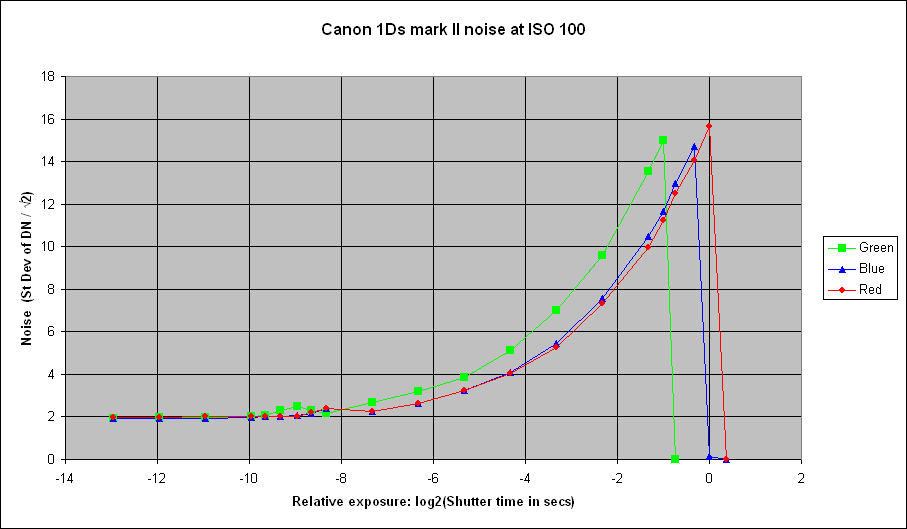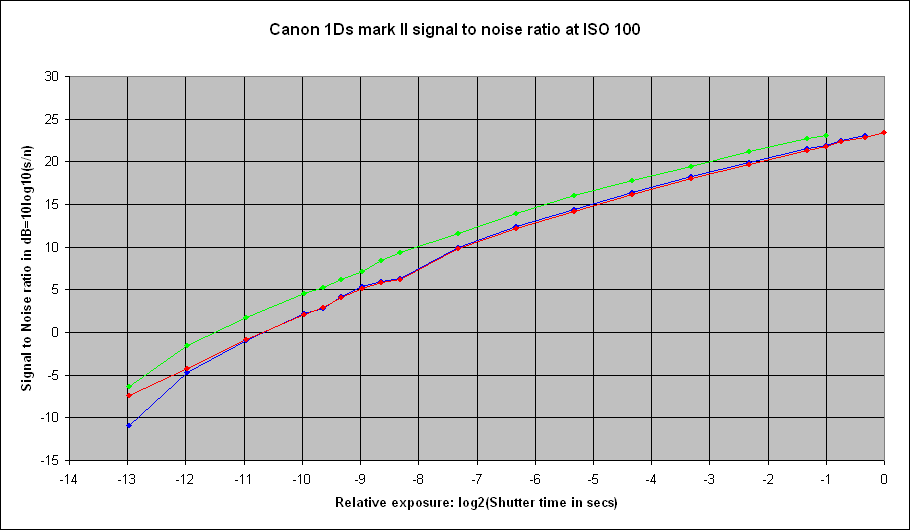The target was a white board lit uniformly. The EF 70-200mm f/2.8L IS lens was used at 200mm and a distance of 1.5m but focussed at infinity; hence the target was heavily defocused in order to obscure any non-uniformities of the board. The camera was set on manual exposure at f/9. This aperture was chosen because a larger one tends to spread out the signal across the camera's histogram.
The shutter speed was varied over a range from 1.6 to 1/8000 of a second so as to cover the full range of exposures from off the lefthand end of the camera's histogram to off the righthand end.
Two shots were taken at each exposure setting. The first shot of each pair gave the mean value of the signal. The two shots were then subtracted and the standard deviation of the difference calculated. The noise is that figure divided by the square root of 2. These calculations were done on a 200 x 200 pixel crop from the centre of the images.
The purpose of the subtraction is to remove, as far as practicable, variations in the signal due to non-uniformity of the target or its lighting, spatial non-uniformity of the sensor response, or dust on the sensor. All of these would be the same for the two shots and are therefore removed upon subtraction.
The camera was set to write 12-bit raw files and all in-camera noise reduction options were turned off. The raw files were processed in such a way as to extract the numbers (referred to as DN for data number) without any alteration. The raw file was split into its red, green and blue components, but no Bayer interpolation (or 'demosaicing') was done.
The statistics of the green component before subtraction are shown in the table here.
The table below shows statistics of a 200 x 200 pixel area in the centre of each image for the green component after the two frames have been subtracted.
It should be noted that the top five exposures are clipped by firmware, and this is why their standard deviation is zero.
These figures are plotted below:

There is a slight rise in the noise between relative exposure -8 and -10 on this graph. I don't know the reason for that.
The unadjusted signal to noise ratio is plotted below on logarithmic scales:

Please note that the vertical decibel scale is 10*log10() and not the 20*log10() used in the audio industry.
One can interpolate a useable dynamic range for the camera at ISO 100 from this data:
By adopting 3dB as the lower bound, rather than the read noise, we are requiring the signal to be at least twice the noise in the shadows. I consider that to be more reasonable from a photographic point of view.
Had we used the read noise rather than the 3dB point as the lower bound, the figure for dynamic range would be 10.9 stops. It is also worth noting in passing that inspection of the lefthand end of this graph shows that both the signal (see here) and the S/N ratio remain well behaved at signal levels below the measured read noise. This is tiresome as it casts doubt upon the validity of the read noise measurement. However, that measurement was perfectly geniune. The difference between the two is that the read noise measurement was an exposure of 1/1000 sec in the dark without a lens fitted, and this measurement is an exposure of 1/8000 sec of an illuminated target with a lens fitted; make of that what you will.
When interpreting this kind of dynamic range measurement, two aspects of the method used here should be noted. First, because we subtract two frames before measuring the noise, the noise measurement we get excludes fixed variations arising from uncorrected differences in the sensitivity of individual pixels. Second, the dynamic range is calculated from a sequence of shots, rather than being measured directly from a single shot. That means that any limitation upon dynamic range imposed by the lens, for example due to flare, is excluded. Practical photography has to contend with both of these aspects.
© Peter Facey, Winchester, England
20080318 originated